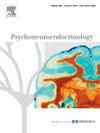Altered circadian pattern of activity in a chronic activity-based anorexia nervosa-like female mouse model deficient for GHSR
IF 3.4
2区 医学
Q2 ENDOCRINOLOGY & METABOLISM
引用次数: 0
Abstract
Anorexia Nervosa (AN) is a psychiatric disorder characterized by voluntary food restriction, resulting in severe undernutrition that has been associated with circadian rhythms alterations. Yet, mechanisms that link circadian rhythm shifts to abnormal eating regulation in AN are poorly understood. Plasma ghrelin concentrations, an orexigenic hormone secreted by the stomach and acting through the GHSR (Growth Hormone Secretagogue Receptor), is elevated in restrictive-type AN. We aimed to test the hypothesis that GHSR signaling contributes to altered circadian pattern observed in AN. For this purpose, we first assessed whether chronotypes (morning, intermediate or evening) were different in patients with AN, bulimia nervosa and healthy controls. We next recorded the pattern of physical activity in young female GHSR deleted (Ghsr-/-) and wild-type (Ghsr+/+) mice housed in cages equipped with running wheels and exposed to quantitative food restriction, mimicking AN metabolic status. We demonstrated that chronotypes were different in the three groups of subjects, a difference mainly driven by an excess of morning chronotype in patients with AN. In mice, the shift toward higher daytime and pre-prandial physical activity and lower night-time and post-prandial physical activity, induced by food restriction, was impaired in Ghsr-/- mice, suggesting a lack of capacity to adapt patterns of circadian activity to chronic food restriction. These data suggest an interaction between altered circadian pattern and AN and indicate that GHSR signaling deficiency may play a critical role in adapting circadian patterns of activity to the undernutrition state in this disorder.
在缺乏GHSR的慢性活动性神经性厌食症样雌性小鼠模型中,活动的昼夜节律模式改变
神经性厌食症(Anorexia Nervosa, AN)是一种精神疾病,其特征是自愿限制食物,导致与昼夜节律改变有关的严重营养不良。然而,将AN中昼夜节律变化与异常饮食调节联系起来的机制尚不清楚。胃促生长素(ghrelin)是胃分泌的一种促氧激素,通过生长激素促分泌受体(Growth hormone Secretagogue Receptor, GHSR)发挥作用,在限制性型an中血浆ghrelin浓度升高。我们的目的是验证GHSR信号有助于改变AN中观察到的昼夜节律模式的假设。为此,我们首先评估了AN患者、神经性贪食症患者和健康对照者的睡眠类型(早晨、中间或晚上)是否不同。接下来,我们记录了年轻雌性GHSR缺失(GHSR -/-)和野生型(GHSR +/+)小鼠的身体活动模式,这些小鼠被安置在装有跑步轮的笼子中,并暴露于定量食物限制中,模拟AN代谢状态。我们证明了三组受试者的时间类型不同,这种差异主要是由于an患者的早晨时间类型过多。在小鼠中,Ghsr-/-小鼠因食物限制而导致的白天和餐前体力活动增加,夜间和餐后体力活动减少的转变受到损害,这表明缺乏适应昼夜节律活动模式的能力。这些数据表明昼夜节律模式的改变与an之间存在相互作用,并表明GHSR信号缺陷可能在这种疾病中使昼夜节律模式适应营养不良状态方面发挥关键作用。
本文章由计算机程序翻译,如有差异,请以英文原文为准。
求助全文
约1分钟内获得全文
求助全文
来源期刊

Psychoneuroendocrinology
医学-精神病学
CiteScore
7.40
自引率
8.10%
发文量
268
审稿时长
66 days
期刊介绍:
Psychoneuroendocrinology publishes papers dealing with the interrelated disciplines of psychology, neurobiology, endocrinology, immunology, neurology, and psychiatry, with an emphasis on multidisciplinary studies aiming at integrating these disciplines in terms of either basic research or clinical implications. One of the main goals is to understand how a variety of psychobiological factors interact in the expression of the stress response as it relates to the development and/or maintenance of neuropsychiatric illnesses.
 求助内容:
求助内容: 应助结果提醒方式:
应助结果提醒方式:


